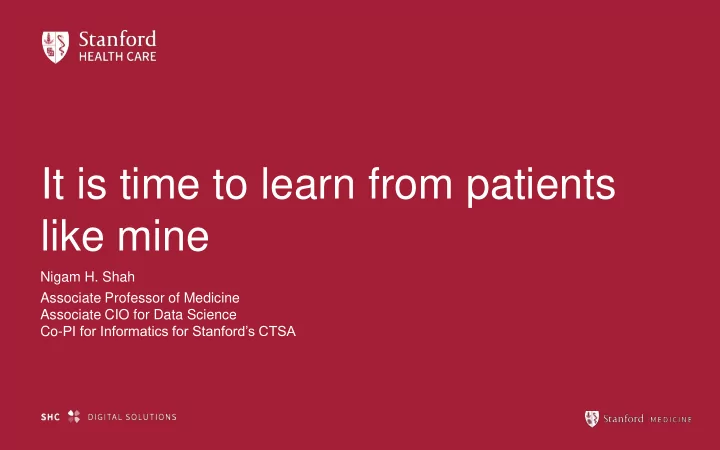

It is time to learn from patients like mine Nigam H. Shah Associate Professor of Medicine Associate CIO for Data Science Co- PI for Informatics for Stanford’s CTSA
Let’s meet Laura A teenager with systemic lupus erythematosus, proteinuria, pancreatitis and positive for antiphospholipid antibodies www.webmd.com/lupus/picture-of-acute-systemic-lupus-erythematosus
The Green Button project • Given a specific case, provide a summary of similar patients in Stanford’s clinical data warehouse, the common treatment choices made, and the observed outcomes. • An institutional review board approved study (IRB # 39709), which served 150 consultations across all service lines. • Invented novel technology to search medical timelines. http://greenbutton.stanford.edu
Timeline 2014 Green button : using aggregate patient data at the bedside (vision paper in Health Affairs) 2015 Outlined steps for rapid cohort studies at the bedside 2016 Built a search engine for patient timelines 2017 Launched a pilot of the service 2018 Described the methods used in the consult service, and a perspective on why “It is time to learn from similar patients” 2019 Completed the pilot study (writing up results)
An example report
Service = software, data, and personnel Green Button Service Software Data Personnel Informatic EMR Data Data AC ACE sear arch engin ngine s Physician Specialist Scientist EMR Claims For patient timelines 6
www.tinyurl.com/search-ehr // patients with cryptogenic stroke var st = Intersect(OR(icd9=436, icd9=434), NOT(OR(icd9=393, icd9=394, icd9=397.1, icd9=397.9, icd9=398, icd9=246, icd9=424.9, icd9=V43, icd9=433.1, icd9=431, icd9=434.11, icd9=434.01)), AGE (40 years, 90 years), VISIT TYPE="INPATIENT", NOT(TEXT="thyroid diseases"), NOT(TEXT="heart valve prosthesis"), NOT(TEXT="disease of mitral valve"), NOT(TEXT="rheumatic heart disease")) // those that got diagnosed with Afib var afib = FIRST_MENTION(icd9=427.31) // those with a cryptogenic stroke, and then Afib in 1 to 5 years SEQUENCE ($st*, $afib)+(-5 years, -1 year)
The process: 24 – 72 hours Debrief Requesting Request on the consult physician decision Refine the question Informatics Create physician definitions Review for exposures results 1. Phenotype definition and Write Build EHR data outcomes consult patient 2. Knowledge graph use specialist report cohorts 3. Cohort generation 4. Searching timelines Perform Data statistica scientist l analysis ACE CE sea search en engine
The first 100 consults 40 30 Internal Medicine Number of consults 20 Oncology Dermatology Cardiology 10 Anesthesiology Pediatrics 0 0 5 10 15 20 25 Unique physicians requesting consult 9
The first 100 consults 10
How ‘reliable’ are the results? 1. Comparing with two reference sets • Applies to the 18 treatment effect estimation consults • 13- 22% were “false discoveries” 2. Comparing across datasets (Truven, Optum) • Agreed 68-74% of the time • About the same rate as how often RCTs agree with each other 3. Comparing patient matching strategies • Agreed 79% of the time
Green button Informatics Consult Consult Service Analysis + Report • The question as posed • How we asked the question • Our interpretation • Research walkthrough
Green button and the Informatics Consult Stanford Health Care Informatics Consult team partners Alison Callahan Ken Jung Saurabh Gombar Vladimir Polony David Entwistle Tip Kim Robert Harrington Rob Tibshirani Trevor Hastie Christopher Sharp Nigam Shah Funding: NLM, Dean’s office School of Medicine, an anonymous donor, Department of Pathology, Center for Population Health Sciences, Stanford Health Care
Related prior efforts 14
Questions that remain • Does having such a consult service change patient outcomes? • How could we enable such consults nationwide? • Could we automate such analyses to be “always on”? • Could we get such a “curbside consult” from multiple health systems? • Could patients benefit from having access to such reports? 15
Recommend
More recommend